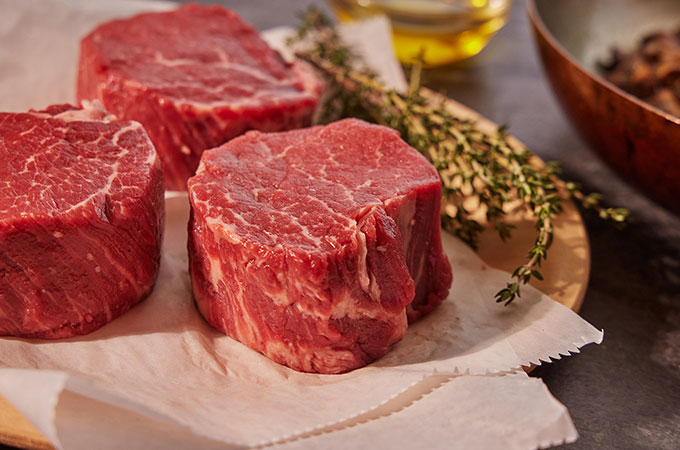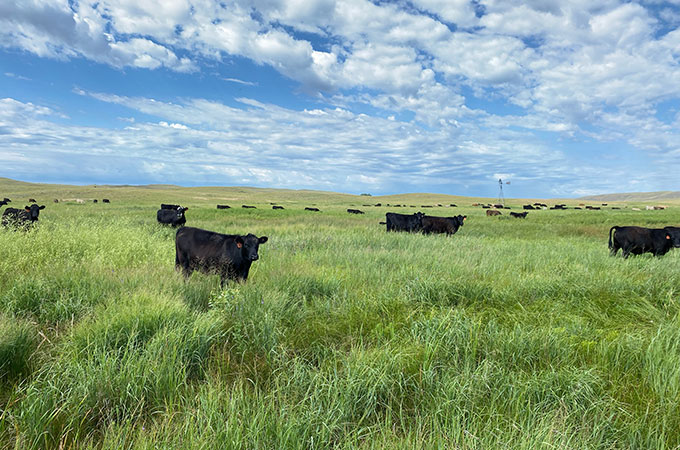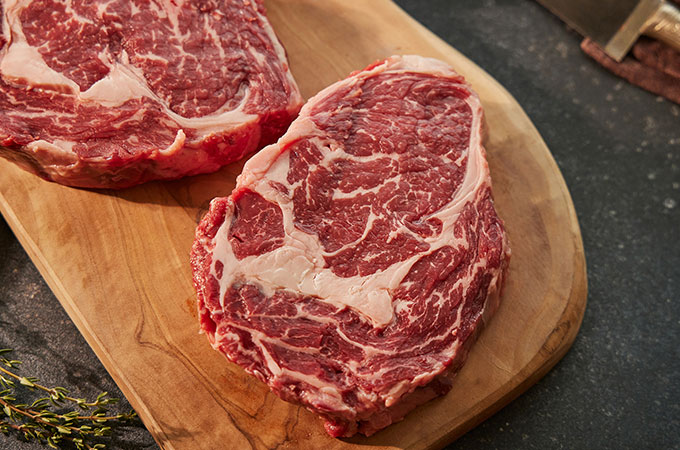We Know our Sources: Heinen’s Organic Beef

The following story was written by Heinen’s partner Elaine T. Cicora.
When it comes to sourcing top-quality beef, Heinen’s has a legacy to live up to. After all, our founder Joe Heinen first made his mark as a butcher, and the first Heinen’s location, opened in 1929, was a butcher shop. Sourcing premium meat is in our DNA. Now, almost a century later, our skilled meat experts remain as committed as ever to bringing in the very best meat, while educating our customers and associates about the farmers and ranchers who stand behind our products.
As customer interest in grass-fed, organic and humanely raised beef has expanded, our meat experts have scoured the world in search of the best product available. Today, we are proud to announce that we have achieved that goal, with a recently formed partnership with Spring Lake Ranch, a 20,000-acre ranch settled in the heart of Nebraska’s unique Sandhills grasslands – the largest intact grasslands in the world, and the ideal place to raise cattle on pasture.
Thanks to a longstanding relationship between Tom Heinen and Doug Cooper, President of boutique meat processor Open Range Beef, Spring Lake Ranch is now providing our customers with what Doug calls, “the best organic, grass-fed and grass-finished beef available” – third-party certified, humanely raised and finished to our unique specifications.
We recently talked with Doug, along with Tim Goodnight (VP of Spring Lake Ranch and in-house cattle nutrition and regenerative grazing expert), and Pete Lewis (Spring Lake Ranch’s Chief Marketing Officer), about the practice and philosophy behind bringing some of America’s best beef to market. Here’s part of our conversation:
Spring Lake Ranch is in the heart of Nebraska’s Sandhills, a mixed-grass prairie that covers just over one quarter of the state. As much as 85-percent of the eco-region is intact natural habitat, with more than 720 different species of plants (most of them native) and a stunning array of birds, mammals and insects. What does this mean for cattle ranching?
Tim Goodnight (TG): Well, the Sandhills are something very special, with a unique combination of rolling hills, native grasslands and wet meadows. The region sits on top of the Ogallala Aquafer (a massive, shallow water-table aquifer that is one of the world’s largest), which makes the meadow grasses grow especially lush.
Pete Lewis (PL): Most important, most of the Sandhills region has never been used for crops; they are not agricultural lands. Large swaths of it have never been plowed, depleted or treated with chemicals of any sort. Instead, the Sandhills have been native grasslands for hundreds of years, so it’s fair to say this land was organic before organic was organic.
TG: Historically, those pastures would be cut and dried for hay. But we know that grazed forages are more nutritious than hay, so we select certain meadows, from year to year, and let the cattle graze them.
PL: We have 44 separate pastures on the land. Tim manages them so that the quality of the grass is never degraded. That’s all part of the regenerative grazing process, which uses the grass to meet the animals’ nutritional needs while using grazing to keep the grasslands healthy.
Additionally, we have seven lakes on the ranch, two of which are over 300 acres in size. About 70 percent of our pastures have year-round water be it a lake or standing water that collects in the meadows. All of our pastures have abundant water sources for the cattle through windmill powered water pumps.
Doug Cooper (DC): So between the grass quality, the regenerative grazing and the abundance of water, the result is a high degree of consistency in the quality of the product.

In fact, that was one of Tom Heinen’s criteria when we launched this partnership: He told us he needs true source verification, great taste, outstanding tenderness and consistency of the product, week after week. So in response, Tim, Pete, I and our colleagues built Spring Lake Ranch’s attributes to fit every one of those criteria.
The Sandhills are referred to as “the Napa of grass.” What does that mean, and what does that mean for the beef?
PL: What Napa Valley is to great Cabernet Sauvignon, the Sandhills are to grass, thanks to its size, the soil quality and even the concept of terroir: The quality of the land adds its own unique flavor to the final product.
Consider this analogy. You can grow grapes anywhere. But unless they are being grown by experts in the ideal location, they’re not going to make great wine. It’s the same with the Sandhills. We are raising grass-fed beef on some of the best, most nutritious grasslands in the world. “You are what you eat,” right? We believe a diet of Sandhills grass builds the best possible flavor and quality.
Tell us about the history of Spring Lake Ranch.
DC: The ranch was founded in 1887 as a cow/calf ranch and remained in the same family until the 1940s. Our group is now the third owner of a property that has been forever organic – and I mean forever!
We purchased the ranch in December of 2021, and I called Tom Heinen in March of 2022. Because of my long relationship with Tom, and Heinen’s outstanding reputation, he was the first call I made when we envisioned the agenda for Spring Lake Ranch.
Let’s talk more about “organic.” What does it mean for beef to be organic?
DC: Simply put, we are raising beef the way it used to be – without antibiotics, hormones or other modern chemicals and additives. Organic beef is never mass-produced in feedlots. Instead, it’s raised in open spaces where the animals can roam free and have access to healthful, nutritious food and water.
PL: In other words, it’s a more natural and harmonious way to raise meat. It takes skill and dedication to raise beef organically. We can’t take shortcuts. It’s a choice, and you make that choice for a variety of reasons. We do it because we believe it’s the right way to raise beef. And we do it because we believe it creates a high-quality product.

DC: It’s the same type of beef that Joe Heinen started his store with. That’s basically the show.
PL: But just because it’s the traditional way to raise beef, doesn’t mean it’s old-fashioned. There have been great improvements in raising beef since Joe Heinen’s day, including the concept of regenerative farming.
Please share more about regenerative farming.
PL: We like to think that at Spring Lake Ranch, we have moved beyond the concept of mere “sustainability” to regeneration.
TG: That means managing the land so that it improves over time. We consider ourselves the land’s stewards. So we use best-in-class regenerative techniques, such as grazing rotation, to ensure that the health of the land just gets better and better – while raising world-class beef! We believe regenerative farming is a step beyond mere sustainability: We are protecting and improving the land for generations to come.
How does being grass-fed and organic-raised benefit your animals?
TG: Well, the natural diet for cattle is grass. Grass is what they were designed to eat, as opposed to mass-produced beef, which are fed an unnatural diet including corn and soy. That kind of diet has a lot of implications for how the animals have to be managed. For instance, mass-produced beef may need antibiotics because their diet doesn’t support good health.

DC: On the other hand, it has been our experience that grass-fed animals like ours are heartier and have fewer illnesses.
PL: Organic isn’t just a way to feed the animals or manage them. It is inherently an animal welfare system. The animal’s welfare is central to the entire concept. Raising them in a natural, low-stress environment, with high standards for handling and care, equals a healthy, contented animal.
“Amazing flavor” and “organic/regenerative/grass-fed” have sometimes seemed mutually exclusive. How does Spring Lake Ranch beef taste?
PL: It tastes the way beef used to taste, with a very rich and beefy flavor.
DC: Our cattle is strictly grass-fed and grass-finished and we are closely audited on that claim. We believe that the grass is the No. 1 flavoring component to our meat.
TG: And the reason our flavor stands out, and is so desirable to the consumer, is because the industrial feedlot diet of corn and soy has created a very bland, neutral-tasting beef. On the other hand, because we are in the “Napa of grass,” we can produce a better flavor. A little bit of salt and pepper is all you need to let that incredible beef flavor shine through.
How about tenderness?
PL: It’s a very tender beef, with a nice, white marbling. We’ve known butchers who looked at that marbling and didn’t believe it was really grass-fed beef. But when they tasted it: “Wow!”

Can you tell us more about your partnership with Heinen’s?
DC: I connected with Heinen’s 30 years ago and was behind Heinen’s own beef program for more than a decade. So when we envisioned the agenda for Spring Lake Ranch, Tom Heinen was the first call I made.
PL: Tom (Heinen) is very invested in knowing his suppliers, and because of his relationship with Doug, this couldn’t be a better example of “know your partners.”
DC: Right, the ranch is managed, designed and third-party audited every step of the way, on Heinen’s behalf. I like to say that Pete, Tim and I can stand in the middle of a field with a Heinen’s representative, and honestly say to them, “Those are your cattle.” So Heinen’s has a voice in everything we do: They are a true partner.
The driving force, of course, is that Heinen’s not only wants to be the best, and sell the best, but they are fully invested in the process. They hold the line on trust and transparency. They aren’t satisfied with “average.” They really care that everybody in the entire system is doing well – and can do it again tomorrow.
What that means is, we are producing world-class meat exclusively for a world-class grocer with great customers.
PL: And we are really proud of that. It’s part and parcel of being in a partnership. Heinen’s customers can’t get this meat anywhere else – and that’s why they should shop at Heinen’s!

Any final words?
PL: Our relationship with Heinen’s has been fantastic.
DC: You know, it all goes back to Joe Heinen and his motto: You have to find the best to sell the best. And we believe the best grass-fed, grass-finished, organic beef available comes from Spring Lake Ranch.


